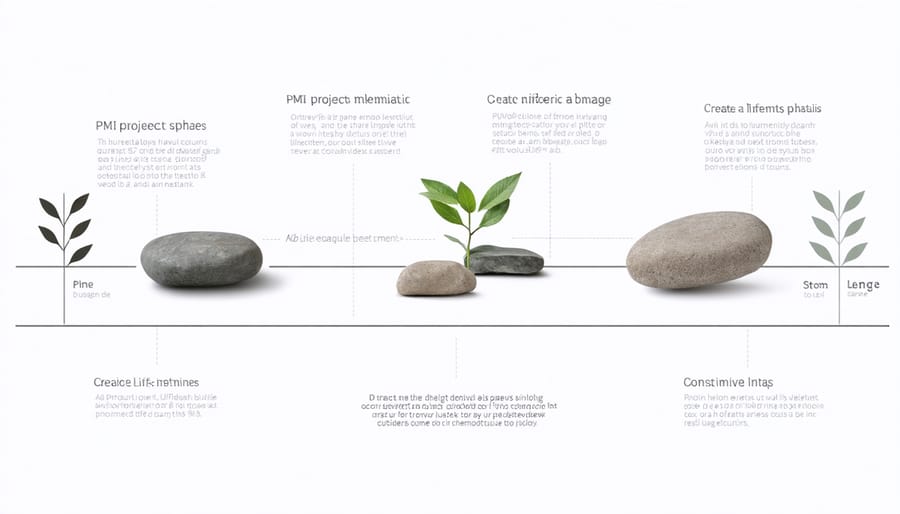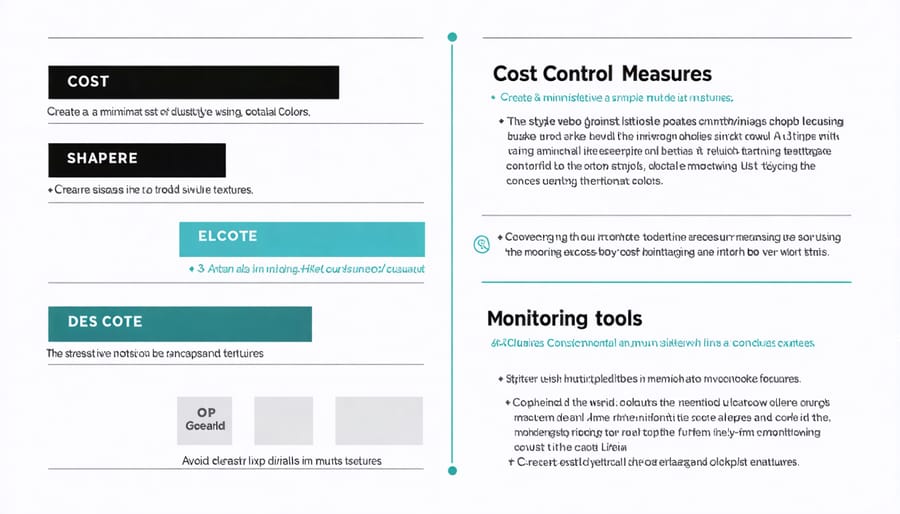Master your stone project’s success by implementing PMI’s structured project lifecycle methodology, a proven framework that transforms complex natural stone installations into manageable, predictable phases. Through detailed lifecycle cost analysis and systematic planning, project managers can effectively control budgets, timelines, and quality outcomes across the entire stone installation process.
The Project Management Institute’s approach divides stone projects into distinct phases – initiation, planning, execution, monitoring, and closure – each requiring specific deliverables and quality gates. This systematic breakdown enables precise resource allocation, risk mitigation, and stakeholder management throughout the project’s duration. By integrating PMI’s best practices with stone industry expertise, organizations can achieve superior results while maintaining strict adherence to budget constraints and quality standards.
For natural stone projects specifically, this methodology provides crucial structure during material selection, fabrication planning, installation sequencing, and long-term maintenance considerations. The result is a comprehensive project management framework that ensures successful outcomes from initial concept through final implementation and beyond.

Understanding PMI Project Lifecycle Phases in Stone Projects
Initiation Phase: Defining Stone Project Parameters
The initiation phase sets the foundation for a successful stone project by establishing clear parameters and expectations. During this crucial stage, project managers must identify key stakeholders, including architects, stone suppliers, contractors, and end users. This collaborative approach ensures all parties understand their roles and responsibilities from the outset.
A comprehensive project charter is developed, outlining the project’s scope, objectives, and deliverables. For stone projects, this includes defining specific material requirements, quality standards, and performance expectations. The charter should address factors such as stone type selection, quantity estimates, and preliminary installation methodologies.
Budget considerations are paramount during initiation. Project managers must conduct initial cost analyses covering material procurement, transportation, installation, and long-term maintenance. This preliminary financial framework helps stakeholders make informed decisions about project viability and resource allocation.
Risk assessment begins at this stage, identifying potential challenges unique to stone projects, such as material availability, weather impacts, and installation complexities. These early insights allow for proactive risk mitigation strategies and contingency planning.
The initiation phase also establishes project governance structures and communication protocols. Regular stakeholder meetings are scheduled, reporting mechanisms are defined, and decision-making processes are documented. This framework ensures smooth project progression and maintains accountability throughout the lifecycle.
Success criteria are clearly defined, incorporating both technical specifications and aesthetic requirements. These metrics serve as benchmarks for project evaluation and guide subsequent planning phases. Stakeholder expectations are aligned through detailed documentation and formal sign-off procedures, creating a solid foundation for project execution.
Planning Phase: Comprehensive Cost Analysis
A comprehensive cost analysis during the planning phase is crucial for successful stone project implementation. This stage requires careful consideration of multiple factors to ensure accurate budgeting and resource allocation. The process begins with material selection and procurement, where project managers must evaluate different stone options based on quality, availability, and price points.
Initial cost considerations should include direct expenses such as raw materials, fabrication, and installation labor. However, equally important are indirect costs like transportation, storage, and specialized equipment rental. Project managers must factor in contingency amounts, typically 10-15% of the base budget, to address potential variations in material prices or unexpected challenges during installation.
Long-term maintenance requirements significantly impact the total cost of ownership. Different stone types require varying levels of maintenance, from regular sealing for marble to minimal upkeep for granite. These ongoing expenses should be calculated over the project’s expected lifespan, typically 20-30 years for commercial applications.
Installation methods also play a crucial role in cost analysis. While some methods may have higher upfront costs, they might reduce long-term maintenance expenses or extend the material’s lifespan. For example, mechanical anchoring systems might cost more initially but can provide better longevity and easier replacement options compared to traditional wet-set installations.
Risk assessment and mitigation strategies should be incorporated into the cost analysis. This includes evaluating potential material price fluctuations, labor market conditions, and scheduling impacts. By considering these factors during the planning phase, project managers can develop more accurate budgets and ensure better financial outcomes.

Lifecycle Cost Components in Stone Projects
Initial Investment Costs
Initial investment costs in natural stone projects require careful consideration of multiple components to ensure accurate budget planning. Material costs typically represent 40-50% of the initial investment, encompassing the stone itself, adhesives, grouts, and sealants. Premium stones like marble or rare granites command higher prices, while standard limestone or slate options offer more economical alternatives.
Installation expenses form another significant portion, usually accounting for 30-35% of upfront costs. This includes skilled labor, specialized equipment rental, and transportation logistics. Professional installation teams typically charge per square foot, with rates varying based on project complexity and geographical location.
Immediate setup requirements comprise the remaining 15-20% of initial costs. These include site preparation, substrate evaluation and remediation if needed, moisture barriers, and necessary permits. Additional considerations might involve temporary storage facilities, protection materials for finished surfaces, and initial sealing treatments.
Project managers should also factor in a 10-15% contingency buffer for unexpected challenges or material variations, ensuring the project remains financially viable despite potential setbacks.
Operational and Maintenance Costs
Operational and maintenance costs form a significant portion of a project’s total lifecycle expenses. During the execution phase, project managers must carefully monitor and control these ongoing expenditures while ensuring quality standards are maintained. Regular maintenance activities typically include scheduled inspections, preventive maintenance tasks, and emergency repairs when needed.
Cost tracking should follow PMI’s earned value management principles, comparing actual maintenance costs against planned expenditures. This helps identify cost variances early and enables proactive decision-making. A well-structured maintenance program typically includes daily cleaning procedures, weekly inspections, and quarterly comprehensive assessments.
Key maintenance cost components include:
– Labor costs for routine maintenance personnel
– Replacement parts and materials
– Specialized equipment rental or purchase
– Training and certification for maintenance staff
– Documentation and reporting systems
– Emergency repair contingencies
To optimize maintenance costs, project managers should implement a reliability-centered maintenance strategy that balances preventive and corrective maintenance activities. This approach helps minimize downtime while avoiding unnecessary maintenance expenses. Regular cost-benefit analysis of maintenance activities ensures resources are allocated efficiently throughout the project lifecycle.
End-of-Life Considerations
When a stone project reaches its end-of-life phase, careful consideration must be given to disposal, recycling, or repurposing options. Following sustainable stone practices can significantly reduce environmental impact while managing costs effectively. Natural stone materials often have excellent recycling potential, with options including crushing for aggregate, repurposing for smaller projects, or donation to architectural salvage organizations. Project managers should factor in demolition costs, transportation expenses, and potential recycling revenue during the initial planning phase. Creating a detailed end-of-life plan helps organizations minimize disposal costs while maximizing material recovery value. It’s essential to research local regulations and available recycling facilities early in the project lifecycle to ensure compliance and optimize resource allocation.
Implementing Cost Control Measures
Effective cost control throughout a stone project’s lifecycle requires a systematic approach aligned with PMI best practices. Begin by establishing a detailed cost baseline during the planning phase, incorporating both direct material costs and indirect expenses such as labor and equipment. Implement earned value management (EVM) techniques to track project performance against planned costs, allowing for early detection of budget variances.
Regular cost monitoring should include weekly or bi-weekly reviews of actual expenditures versus budgeted amounts. This practice, combined with proper project risk management, helps identify potential cost overruns before they become significant issues.
Key cost control measures include:
– Implementing change control procedures to evaluate the financial impact of scope modifications
– Maintaining detailed cost records for materials, labor, and equipment
– Utilizing cost performance indexes (CPI) to measure efficiency
– Establishing supplier agreements with fixed pricing where possible
– Creating contingency reserves for identified risks
For stone projects specifically, focus on material waste reduction through precise cutting specifications and inventory management. Consider value engineering opportunities without compromising quality, such as optimizing stone selection based on application requirements and exploring alternative installation methods that maintain integrity while reducing labor costs.
Regular stakeholder communication regarding cost performance ensures transparency and allows for timely corrective actions when necessary. Document lessons learned throughout the project to improve future cost estimation and control processes.

Successful stone project management requires a thoughtful integration of PMI principles throughout the project lifecycle. By following the key phases – initiating, planning, executing, monitoring, and closing – professionals can ensure better outcomes and sustainable value in their stone installations.
Remember to conduct thorough material analysis during the initiation phase, develop comprehensive project plans that account for stone-specific requirements, and implement robust quality control measures during execution. Regular monitoring of timelines, costs, and quality metrics helps maintain project health, while proper documentation during closure provides valuable insights for future projects.
For optimal results, focus on:
– Detailed scope definition that addresses stone selection and application requirements
– Realistic timeline planning that accounts for material procurement and installation
– Risk assessment specific to natural stone characteristics
– Quality control processes tailored to stone specifications
– Clear communication channels between stakeholders
– Proper documentation of lessons learned
By embracing these PMI lifecycle principles while considering the unique aspects of stone projects, professionals can deliver superior results that meet both aesthetic and functional requirements while maintaining budget and timeline constraints.










